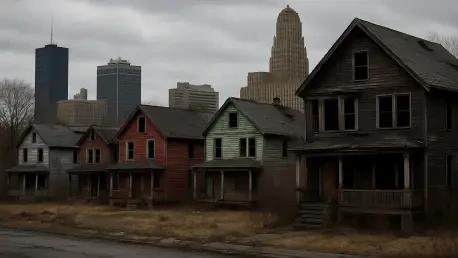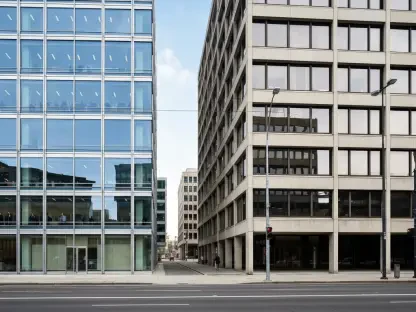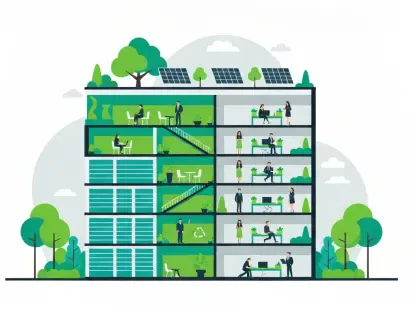In the heart of Buffalo, Western New York, a financial storm is brewing around Doug Jemal, a prominent real estate developer from Washington, D.C., whose ambitious projects have long been a cornerstone of the region’s urban revival, but now face severe challenges. His company, Douglas Development, is grappling with nearly $3.7 million in mechanics liens filed by contractors over the past 18 months, signaling a severe cash flow crisis that threatens to derail major developments. These liens, which allow unpaid contractors to claim an interest in property as a means of securing payment, have cast a shadow over high-profile sites like Seneca One, the city’s tallest building, and the historic Statler Hotel. While Jemal acknowledges the payment delays and claims to be addressing them, the mounting legal actions and stalled projects paint a troubling picture. This situation raises critical questions about the sustainability of his ventures and the broader challenges facing the real estate industry in a tough economic climate.
Financial Struggles in Buffalo
Mounting Liens and Unpaid Debts
A staggering $3.7 million in mechanics liens has been filed against Douglas Development since March of last year, with the majority of claims emerging in just the past five months, highlighting the escalating financial strain on Jemal’s operations in Western New York. These liens target marquee projects such as Seneca One, a symbol of Buffalo’s skyline, and the iconic Statler Hotel, both of which have become battlegrounds for frustrated contractors seeking payment for their work. The legal filings, initiated by eight companies and totaling 27 separate claims, underscore a pervasive issue of delayed compensation that has strained business relationships. While some debts, including a substantial $1.6 million payment to Industrial Power & Lighting, have reportedly been settled, others remain in limbo, with negotiations ongoing for significant sums like the $1.5 million owed to DV Brown and Associates.
Beyond the headline figures, the complexity of these disputes adds another layer of difficulty, as smaller contractors also await payment for amounts that, while less substantial, are critical to their survival. A notable case involves Buf DL LLC, which has escalated a $151,701 claim for water damage repairs into a lawsuit, reflecting a breakdown in resolution efforts. Jemal and his vice president, Paul Millstein, have publicly admitted to the cash flow challenges but maintain that efforts are underway to address all outstanding debts. However, the concentration of liens in recent months suggests that these efforts may be falling short of contractor expectations, raising concerns about the long-term impact on trust and collaboration within the local construction community.
Project Delays and Community Impact
The financial woes plaguing Douglas Development have led to tangible setbacks in Buffalo, with numerous projects either slowing to a crawl or grinding to a complete halt, much to the dismay of stakeholders banking on urban renewal. Developments like the Statler Hotel, a historic gem in need of extensive renovation, are stalled as Jemal struggles to secure the necessary financing to move forward. Similarly, plans for the Richardson complex have been abandoned entirely, and properties such as the former Mahoney state office building are now on the market as part of a broader effort to shed underperforming assets. These delays not only disrupt project timelines but also hinder the momentum of revitalization efforts that have been central to Buffalo’s economic and cultural resurgence over recent years.
Equally concerning is the ripple effect on smaller contractors, whose livelihoods are jeopardized by the delayed payments that have become a hallmark of Jemal’s current operations. For many of these vendors, the outstanding debts represent a significant portion of their revenue, creating a domino effect of financial instability within the local economy. The broader community feels the impact as well, as stalled projects delay job creation and infrastructure improvements that residents have come to expect from large-scale developments. With 57 properties under Jemal’s control through various LLCs, the potential for widespread disruption looms large, casting doubt on the developer’s ability to fulfill long-standing commitments to the city’s growth.
Broader Economic Challenges
Industry-Wide Pressures
Jemal’s financial difficulties in Buffalo cannot be viewed in isolation, as they are deeply intertwined with macroeconomic forces that are squeezing real estate developers across the nation. High interest rates have dramatically increased the cost of borrowing, making it harder for companies like Douglas Development to finance ongoing projects or refinance existing debt. Coupled with tightened lending conditions imposed by federal banking regulations, which demand higher reserves against potential mortgage defaults, the environment for securing capital has become extraordinarily challenging. Jemal himself has described this as a “pandemic of real estate,” emphasizing that the diminished demand for office and retail spaces further compounds the pressure on developers to generate revenue.
This hostile market dynamic is not unique to Jemal’s portfolio, as many in the industry are facing similar struggles, with some resorting to defaulting on loans or returning properties to lenders to cut losses. The shrinking appetite for commercial real estate, driven by shifts in work patterns and consumer behavior, has left developers with properties that are harder to lease or sell at profitable rates. For Douglas Development, these conditions exacerbate internal cash flow issues, making it difficult to meet obligations to contractors while maintaining progress on ambitious projects. The systemic nature of these challenges suggests that resolution may require broader policy interventions or market adjustments, rather than individual fixes alone.
Struggles Beyond Buffalo
The scope of Jemal’s financial turmoil extends far beyond Western New York, with significant setbacks in Washington, D.C., where Douglas Development is headquartered, adding to the strain on his overall portfolio. Reports indicate a staggering $4.6 million in unpaid taxes across nearly 50 properties, alongside a default on a $52 million loan that has further eroded the company’s financial standing. Additionally, the foreclosure of three properties in D.C.’s Chinatown earlier this year marks a severe blow, reflecting the depth of the crisis in the nation’s capital. These issues highlight how interconnected Jemal’s operations are across regions, with troubles in one area potentially undermining stability elsewhere.
Jemal attributes part of these D.C. challenges to federal policy shifts, particularly citing lease cancellations for government office spaces as a critical hit to his revenue stream, which previously relied on such contracts for over 10% of income. This reduction in demand, combined with the same high interest rates and tight credit markets affecting Buffalo projects, creates a compounded burden that stretches resources thin. The cross-state nature of these struggles reveals a pattern of overextension, where ambitious growth across multiple markets may have left Douglas Development vulnerable to simultaneous downturns. As a result, the financial health of the company as a whole remains precarious, influencing its ability to resolve contractor disputes in any single location.
Jemal’s Strategic Response
Debt Settlement and Asset Management
In response to the mounting financial pressure, Douglas Development has taken steps to address the backlog of unpaid debts, though the pace and scope of these efforts remain points of contention among affected contractors. Jemal and his team report having settled over half of the $3.7 million in liens filed in Western New York, with a significant $1.6 million payment to Industrial Power & Lighting standing as a key achievement in this regard. Smaller debts, such as the $161,692 owed to Heritage Contract Flooring, are also slated for prompt resolution, with Jemal expressing a commitment to protecting “the little guy” from prolonged hardship. However, not all claims are being handled smoothly, as evidenced by the contested $151,701 debt with Buf DL LLC, which has escalated into legal action.
Parallel to debt settlement efforts, a strategic pivot toward asset management is underway, with Jemal looking to offload properties that are deemed a drain on cash flow. The decision to put assets like the former Mahoney state office building up for sale reflects a pragmatic approach to reducing financial liabilities in a market where bank financing is increasingly elusive. This divestment strategy, while potentially stabilizing in the short term, raises questions about the long-term vision for his Buffalo portfolio, as selling off key properties could limit future growth opportunities. Balancing debt repayment with asset liquidation remains a delicate act, with outcomes that could redefine Jemal’s presence in the region.
Financing Hurdles and Project Prioritization
Securing adequate financing stands as one of the most formidable barriers to resolving Douglas Development’s current crisis, with specific projects like the Statler Hotel illustrating the scale of the challenge. A reported $35 million financing gap exists for the hotel’s renovation, a sum needed to match Jemal’s existing equity investment and bring the project to completion. In a market where lenders are cautious due to high interest rates and stringent regulations, obtaining such funding is no small feat, leaving the historic property in a state of limbo. This situation exemplifies the broader difficulty of accessing capital, a hurdle that affects not just one project but the entire portfolio’s forward momentum.
As a result of these financing constraints, Jemal has been forced to prioritize certain initiatives over others, often at the expense of promising but resource-intensive developments. The decision to slow or halt work on numerous Buffalo projects, alongside backing out of commitments like the Richardson complex, reflects a calculated retreat to preserve limited resources for more viable endeavors. This selective approach, while necessary under current conditions, risks alienating stakeholders who anticipated steady progress on all fronts. Looking ahead, the ability to navigate these financing hurdles will likely determine whether stalled projects can be revived or if further downsizing becomes inevitable, shaping the future trajectory of Jemal’s operations in Western New York.
Navigating a Path Forward
Reflecting on the challenges faced by Doug Jemal and Douglas Development, it becomes evident that the road to recovery is fraught with complexity, as unpaid debts and stalled projects have left a lasting mark on Buffalo’s landscape. The $3.7 million in mechanics liens, coupled with financial struggles in Washington, D.C., paint a stark picture of a developer caught in a perfect storm of internal and external pressures. Moving forward, a critical step lies in accelerating debt resolutions, particularly for smaller contractors whose stability is most at risk, to rebuild trust and maintain vital business relationships. Securing innovative financing solutions, potentially through public-private partnerships or alternative lending sources, could provide the lifeline needed to restart key projects like the Statler Hotel. Additionally, a transparent dialogue with community stakeholders might mitigate the broader impact on urban renewal efforts, ensuring that Buffalo’s growth aspirations are not indefinitely delayed by these financial setbacks.









